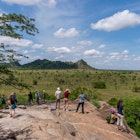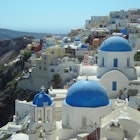

With wonderful beaches, traditional culture and amazing food, experience the best of Ghana with these top places to visit ТЉ Gerhard Pettersson / Shutterstock
With stunning beaches, rich culture and vibrant cities, plus a stable democracy and tourism-friendly infrastructure, the West African country of Ghana is one of the most interesting and accessible destinations on the continent т it's even been called "Africa for beginners."
Situated between CУДte d'Ivoire and Burkina Faso, this hot spot has a colorful traditional heritage to explore т largely through spicy food, bright African art and historical colonial sights. Accra is the capital and the country's cosmopolitan hub, but there are sights to see outside the city limits as well, all easy to reach with great attractions.
Experience the best of Ghana with these top places to visit.
YouTube video player
1. Accra is best place to go for Ghanaian art, food and nightlife
Ghanaтs capital is an open door to the countryтs culture т a gateway to Ghanaian, art, food and nightlife. Choose from elegant nightspots such as the rooftop or the stylish , tailored to tourists, expats and diasporas that can afford the high prices, and eateries offering a more down-to-earth taste of Ghanian cuisine, such as Auntie Muni Waakye and Bush Canteen, which serve local favorites like jollof rice, made with tomato sauce and spices, and waakye, a black-eyed-pea dish.
In the galleries, youтll find images of Ghanaian social life from up-and-comers such as Kwesi Botchway and Afia Prempeh, and internationally recognized artists including Serge Clottey and Betty Acquah. Pieces from Ghanaian and African artists as a whole are captured inside showrooms across the city т contemporary art at Gallery 1957, older African works at Berj Gallery and rotating visual-art installations at the Nubuke Foundation, to name just a few.
2. Tamale has arts and crafts and Islamic architecture
Tamale is the northern capital of Ghana, and it has a great blend of architecture both old and new, from modern high-rises to buildings dating as far back as 150 years.
One highlight is the Tamale Central Mosque т it has the capacity for thousands of Muslim worshipers, hundreds of whom visit in droves for daily prayers. The mosque is located right in the center of the city, standing out with its green-topped minaret; a step inside reveals a range of multicolored patterned mats gracefully lining the floor, ready for prayer.
Tamale is also known for its arts and crafts. To pick up unique souvenirs or simply browse the wares, visit the National Cultural Centre, where youтll find items like jewelry, drums and handmade baskets intricately woven from grass, straw and bamboo.
Detour: Another example of impressive architecture is the Larabanga mosque, located about 116km (72 miles) west of Tamale. Dating back to 1421, itтs recognized as one of West Africaтs oldest mosques, built in a Sudano-Sahelian style using mud and reeds, with tall white walls and towers that curve inward. It's a good photo op т most tourists capture the mosqueтs iconic architecture from the outside.

3. Kumasi is the best place to visit for Ashanti tradition and culture
Kumasi is the second-largest city in Ghana, and its people т known as Ashanti т have a cultural history and language that have remained dominant in the region for centuries. To learn more about this rich heritage, stop by Manhyia Palace.
Now a museum dedicated to the Ashanti monarchy and traditions, it was built in 1925 by the British colonial government for King Asantehene Agyeman Prempeh I after he returned from nearly three decades of exile in the Seychelles (though he refused to move in until the Ashanti had paid for the building themselves).
The palace would remain home to the monarchy for several generations, until Otumfuo Opoku Ware II relocated to a new residence in 1974. Two decades later, it was converted into a museum with exhibits displaying items from the royal family, such as wardresses, the customary regalia used during royal activities, and talking drums, which function as a communication device to celebrate and mourn during gatherings. Every pulse of the drum has a unique way of speaking to the Ashanti people.
Planning tip: Kumasi is home to numerous celebrations т time your visit just right to be part of one of them. The Akwasidae Festival occurs every sixth Sunday to honor past kings, invoking their blessings by calling upon their names.

4. Aburi is best for families and green spaces
Located less than an hourтs drive from Accra, Aburi has fresh air in abundance, making it a perfect spot to escape the buzz of the capital and spend some time with nature. For a relaxing day trip, Aburi Botanic Gardens is particularly popular with families, who come to stroll alongside the towering palm trees and snap a picture to commemorate the occasion т posing by the palms is a signature move.
Featuring trees that arrived in the late 19th century from far-flung locales in Central America, Mexico, Malaysia, India and the Caribbean, as well as orchids, rock gardens and a children's park, the gardens also include 13 hectares (32 acres) of uncultivated land, kept in a wild state to maintain ecological balance. While youтre wandering the grounds, keep an eye out for an array of contributions planted by visiting dignitaries, such as the mahogany tree from Queen Elizabeth II in 1961 and the silver oak from Prince Charles in 1977.
5. Learn about colonial history at Cape Coast
Situated on the Atlantic Coast, Cape Coast was once a hub for the transatlantic slave trade, and Cape Coast Castle played a key role, housing enslaved people from the 16th to the 17th centuries.
First built by the Dutch and later captured by the British, the fort's whitewashed walls bely the dark history inside т as US President Barack Obama remarked when he visited in 2009, itтs a site that тreminds us of the capacity of human beings to commit great evil.т
Today it's on the Unesco World Heritage List, and guided tours take visitors into the dungeons and along the ramparts to explore this period of Ghanaтs colonial history. The West African Historical Museum is located inside the castle and contains a significant collection of ceremonial drums and ancient pottery.

6. Head to the Volta Region for outdoor adventure
The Volta Region is home to Mt Afadjato, one of the tallest mountains in Ghana. A climb to the top takes about two-and-a-half hours and rewards hikers with incredible views of both Ghana and neighboring Togo to the east. Along with local flora, you can expect to see hippos, tortoises, lizards and butterflies.
The region is also home to a monkey sanctuary and myriad waterfalls, including West Africaтs highest, Wli Waterfalls, whose clean, gushing waters mark the border between Ghana and Togo. A 30-minute walk leads to the lower falls, and then itтs a longer climb to the upper falls; there are pools at the bases of both sets where you can take a cold dip, spotting monkeys in the surrounding trees and bats in the nearby cliffs.
Planning tip: Stop at the Wli Tourist Office for a guide; youтre not allowed up to the falls without one.
7. Ada Foah is best for water sports
On the coast of southern Ghana, Ada Foah sits where the Volta River empties into the Atlantic Ocean т a remote stretch of real estate with long beaches and plentiful opportunities for water sports. Rent a speedboat to hop from beach to beach, or take your time and kayak along the palm-lined waterways for a slower-paced experience.
Places like capture the essence of Ada, with waterfalls, ponds and aquariums onsite and peacocks running free on the grounds. Check out Baffour Falls, where there are pelicans and a tortoise to be fed.
Explore related stories



 Budget TravelHow to visit Ghana on a budget: save your cents with our top tips
Budget TravelHow to visit Ghana on a budget: save your cents with our top tipsApr 11, 2023 тЂ 5 min read






